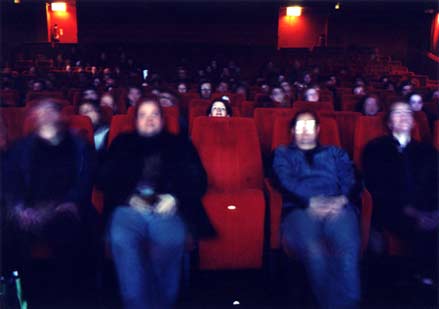|
Photographs by
Stephen Gill
Venue : Queens Hotel, City Square,
Leeds
Dates : 27th Sept - 3rd October 2001
Times : 6pm - 5.30am
Price : Free

'I never knew what the pictures would look like - which was very
appealing, very exciting.' - Stephen Gill
'The poet and film director Jean Cocteau, always happy to get mystical
about the mundane, was fond of describing the cinema audience as
a kind of mass seance. 'The darkness of the theatre and the lunar
glow of the screen,' he once wrote, 'are quite liable to produce
the collective hypnosis exploited by Indian fakirs.' I think he
would have liked Stephen Gill's photographs of audiences at London's
Prince Charles Cinema, because even the least fanciful observers
would have to concede that you can see ghosts here. These pictures
are haunted by the audience itself - as they fidget and shift, unable
to escape from the delicious headlock of Hollywood.
For Cocteau it was the film itself that was the spirit - taking
hold of a disparate group of people and moulding them into a single,
multi-headed organism - and that sense of willing surrender to a
form of possession finds an echo in Gill's explanation of what he
was trying to capture: 'I always started about 10 minutes into the
film,' he says, 'because that's the time I was really interested
in
that moment when the film takes you'. And that film takes us
all in different ways is one of the revelations of his pictures.'
- Thomas Sutcliffe (Independent Magazine 10th March 2001)

Photographs by Julius Shulman
Venue : Queens Hotel, City Square, Leeds
Dates : 4th October - 12th October 2001
Times : 6pm - 5.30am
Price : Free

One of the central characteristics of Modernism has been its impulse
to organise space. The impulse has been manifested in many ways:
photography's particular arrangement through flattening and framing,
its presentation of the system of perspectival viewing as natural,
is one such technique. Elsewhere, modernity has redefined space
through law - town planning, industrial zoning - fixing the once
haphazard boundaries of the urban against the rural, cleansing the
medieval muddle of lanes and alleyways. We know - or like to think
we know - when our cities begin and end, we know - or like to think
we know - where we are going. Perhaps above any other characteristic,
though our experience of modernity has been expressed through architecture.
America was, of course, the perfect place for Utopia. Julius Shulman
was fortunate enough to be a young photographer in Southern California
at the moment when the Depression turned slowly to economic revival,
and a few brave spirits commissioned equally inventive architects.
It is as if Shulman shared the architect's utopian idealised vision
of space - a vision inevitably compromised by the effects of the
weather, the building's interaction with landscape - and can through
the modernist technology of seeing revive and refresh that ideal.
We see perfect homes for perfect lives: the modernist dream, whether
in Adolph Loos' and Walter Gropius' designs for egalitarian communities,
or in the homes and offices built by Koenig, Frey or Neutra for
wealthy individuals and successful corporations.
That point is where the Modernist Utopia meets American Dream. The
beautiful people posed in Koenig's Case Study House no.22, or Buff,
Straub and Hensman's Bass House, are idealisations that match people
to space - the perfect citizen - consumers of Eisenhower's America.
But these buildings are strangely un-American. At odds with the
limited vernacular of the colonist's architectural heritage and
profoundly conservative appropriations from classicism and older
European styles.
Shulman's genius is to realise the radicalism, the designs for living,
that these buildings contain, to construct a vision that promises
perfect light, uncluttered space, unrestricted vistas. From being
a 'mere' technology of documentation, in Shulman's hands, as instrument
of Shulman's gaze, the camera becomes a means of visualising the
brightest dreams of the past century.
- Dr Chris Townsend, Royal Holloway University of London
|